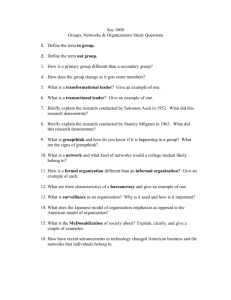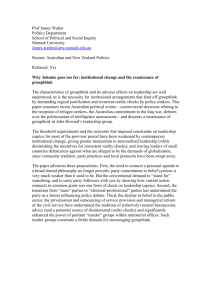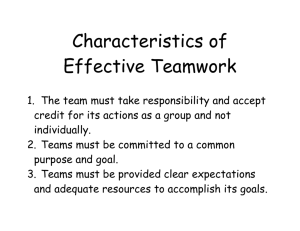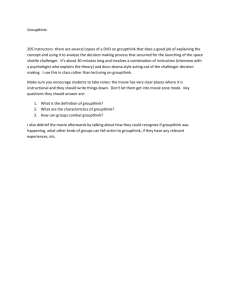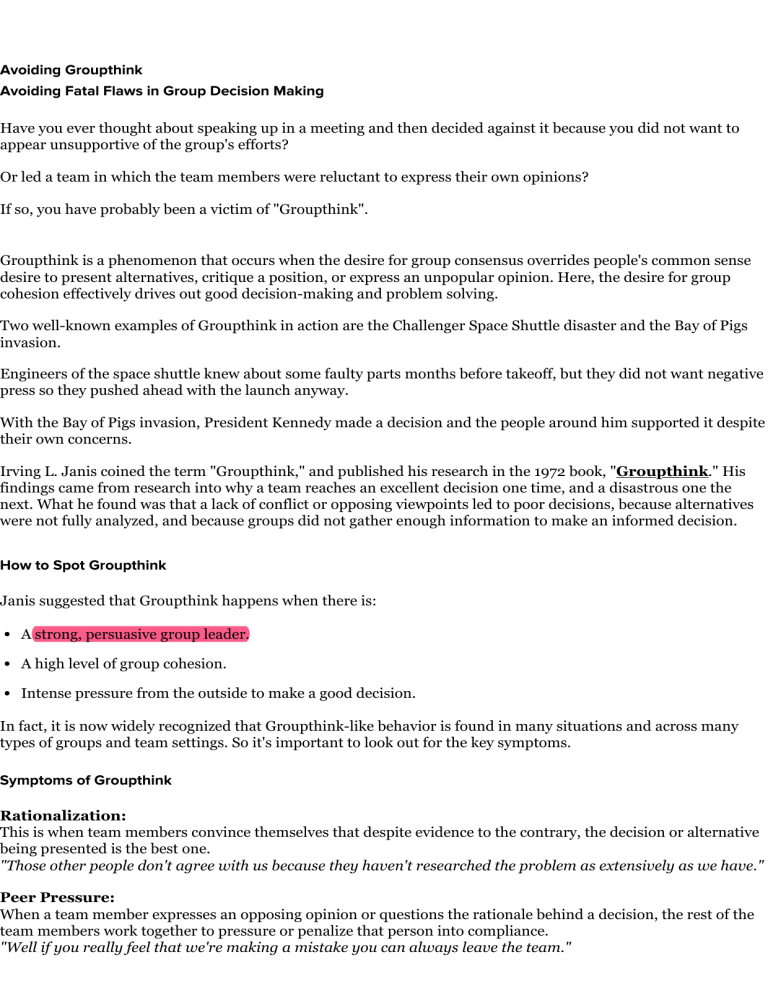
Avoiding Groupthink Avoiding Fatal Flaws in Group Decision Making Have you ever thought about speaking up in a meeting and then decided against it because you did not want to appear unsupportive of the group's efforts? Or led a team in which the team members were reluctant to express their own opinions? If so, you have probably been a victim of "Groupthink". Groupthink is a phenomenon that occurs when the desire for group consensus overrides people's common sense desire to present alternatives, critique a position, or express an unpopular opinion. Here, the desire for group cohesion effectively drives out good decision-making and problem solving. Two well-known examples of Groupthink in action are the Challenger Space Shuttle disaster and the Bay of Pigs invasion. Engineers of the space shuttle knew about some faulty parts months before takeoff, but they did not want negative press so they pushed ahead with the launch anyway. With the Bay of Pigs invasion, President Kennedy made a decision and the people around him supported it despite their own concerns. Irving L. Janis coined the term "Groupthink," and published his research in the 1972 book, "Groupthink." His findings came from research into why a team reaches an excellent decision one time, and a disastrous one the next. What he found was that a lack of conflict or opposing viewpoints led to poor decisions, because alternatives were not fully analyzed, and because groups did not gather enough information to make an informed decision. How to Spot Groupthink Janis suggested that Groupthink happens when there is: A strong, persuasive group leader. A high level of group cohesion. Intense pressure from the outside to make a good decision. In fact, it is now widely recognized that Groupthink-like behavior is found in many situations and across many types of groups and team settings. So it's important to look out for the key symptoms. Symptoms of Groupthink Rationalization: This is when team members convince themselves that despite evidence to the contrary, the decision or alternative being presented is the best one. "Those other people don't agree with us because they haven't researched the problem as extensively as we have." Peer Pressure: When a team member expresses an opposing opinion or questions the rationale behind a decision, the rest of the team members work together to pressure or penalize that person into compliance. "Well if you really feel that we're making a mistake you can always leave the team." Complacency: After a few successes, the group begins to feel like any decision they make is the right one because there is no disagreement from any source. "Our track record speaks for itself. We are unstoppable!" Moral High Ground: Each member of the group views him or herself as moral. The combination of moral minds is therefore thought not to be likely to make a poor or immoral decision. When morality is used as a basis for decision-making, the pressure to conform is even greater because no individual wants to be perceived as immoral. "We all know what is right and wrong, and this is definitely right." Stereotyping: As the group becomes more uniform in their views, they begin to see outsiders as possessing a different and inferior set of morals and characteristics from themselves. These perceived negative characteristics are then used to discredit the opposition. "Lawyers will find any excuse to argue, even when the facts are clearly against them." Censorship: Members censor their opinions in order to conform. "If everyone else agrees then my thoughts to the contrary must be wrong." Information that is gathered is censored so that it also conforms to, or supports the chosen decision or alternative. "Don't listen to that nonsense, they don't have a clue about what is really going on." Illusion of Unanimity: Because no one speaks out, everyone in the group feels the group's decision is unanimous. This is what feeds the Groupthink and causes it to spiral out of control. "I see we all agree so it's decided then." How to Avoid Groupthink The challenge for any team or group leader is to create a working environment in which Groupthink is unlikely to happen. It is important also to understand the risks of Groupthink – if the stakes are high, you need to make a real effort to ensure that you're making good decisions. To avoid Groupthink, it is important to have a process in place for checking the fundamental assumptions behind important decisions, for validating the decision-making process, and for evaluating the risks involved. For significant decisions, make sure your team does the following in their decision-making process: Explores objectives. Explores alternatives. Encourages ideas to be challenged without reprisal. Examines the risks if the preferred choice is chosen. Tests assumptions. If necessary, goes back and re-examines initial alternatives that were rejected. Gathers relevant information from outside sources. Processes this information objectively. Has at least one contingency plan .

